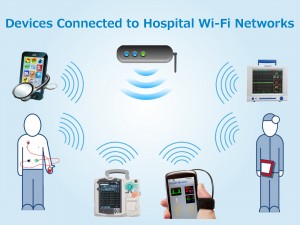
Engineering the Wireless Hospital: Mobility and Connectivity
Published on July 18, 2013

By: Natalie Sheerer, Marketing Specialist
In hospitals where wireless medical devices transmit data that are critical to patient care, it is crucial that these devices never lose connectivity, even when the devices are on the move. Mobility is particularly crucial in hospitals because of the dynamic nature of the environment; patients with body-worn sensors, nurses with workstations-on-wheels, and doctors with wireless medical devices are constantly moving around.
Mobility and connectivity are critical for wireless medical devices
In a Wi-Fi context, mobility means the ability of a client device to roam, or switch, from one access point (AP) to another while still maintaining an active network connection. When roaming is effective, client devices can move from one area to another and roam from AP to AP without disrupting applications that require a persistent network connection.
A Wi-Fi client device will roam from one AP to another when its current connection becomes suboptimal. As the client moves away from the AP to which it is connected, the strength of the signal decreases and RF interference in the area generally increases. Due to the decreased signal strength and increased interference, some transmitted data packets are not received, forcing the sender to retry the transmission. To maintain the Wi-Fi connection, the client and AP negotiate a lower data rate. If the client continues to move away from the AP, then it eventually reaches the edge of coverage for that AP, where the Wi-Fi connection can be maintained only at the lowest data rate supported by that AP. Beyond the AP edge of coverage, the client is out of range, and the connection with the AP is lost. Therefore, to prevent loss of coverage, the client will switch to an AP with stronger signal, thus preventing a drop in connectivity.
While the physical movement of a client is the most common trigger for roaming, it is also possible for a stationary device to roam. Suppose that a stationary device is within range of two APs and connected to one of them. If a patient, doctor, nurse or hospital visitor positions his or her body between the device and the AP it is connected to, their body may block enough of the Wi-Fi signal that the client is forced to roam to the second AP to avoid losing its connection.
The process of roaming is more complex that just switching from one AP to another. There are four steps involved in the process:
- Evaluate: Determine if the connection with the current AP is less than optimal.
- Scan: If the connection is less than optimal, then scan the vicinity for other APs.
- Select: Determine if any AP within range is likely to provide a better connection than the current AP.
- Roam or Repeat: Roam from the current AP to the best candidate in the vicinity, or determine when to repeat the process beginning at step 1 again.
The most common way to evaluate the current connection is to compare the strength of the RF signal from the current AP to a configured threshold value. If the signal strength is weaker than the threshold, then the client must look for an AP that offers a better connection.
To determine which APs are within range of the device, the client radio must scan every frequency channel. There are two ways that a client device can scan these Wi-Fi channels: actively and passively. The more efficient scan is an active scan, where the client radio issues a probe request and listens for a probe response from an AP. With a passive scan, the client radio listens on each channel for beacons, which APs send out periodically. The risk with a passive scan is that the client may miss the AP’s beacon if the client does not listen long enough on a given channel.
After scanning, the client selects the AP that is likely to offer the most reliable connection. The decision typically is based on the strength of signal from the AP, because that is the only relevant information that a client can glean from a typical AP’s probe response. There is one risk that goes along with the scanning process. While a client radio is doing active or passive scanning, it cannot interact with the AP with which it is connected. The longer the scanning process takes, the more risk that there will be a disruption in the current connection. This is especially important in healthcare settings where some device applications are life-critical.
Some 5 GHz channels require support for dynamic frequency selection (DFS). A Wi-Fi client device cannot do active scans on DFS channels but must rely on passive scans. Longer scan times make it more difficult to keep a connection active while roaming across APs. For this reason, it is preferable for mobile medical devices to avoid using 5 GHz channels which mandate support for DFS.
It is important to note that a client radio cannot be associated, or connected, to two APs at the same time. Once it decides to roam to a new AP, the client must disassociate from its current AP and associate to the new one. After associating to the new AP, the client must re-authenticate to the network that the new AP is on. Once the client completes the roam, the two APs must interact to ensure that the infrastructure is aware that the client has moved from one AP to another.
Not all wireless medical devices have the same Wi-Fi mobility and roaming capabilities. It is important that hospital IT professionals choose wireless medical devices that have embedded Wi-Fi modules which go through the roaming process quickly and seamlessly.